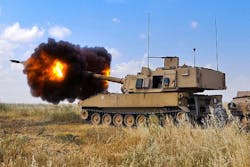BAE Systems to upgrade more Paladin 155-millimeter artillery systems with digital fire control
WARREN, Mich., 22 May 2015.Vetronics experts at BAE Systems upgrade U.S. Army M109A6 Paladin 155-millimeter self-propelled artillery systems with digital fire control capability under terms of a $16.5 million contract modification announced Thursday.
Officials of the Army Contracting Command in Warren, Mich., are asking engineers at the BAE Systems Platforms & Services segment in York, Pa., to install the Paladin Fire-Control System in Paladin artillery vehicles.
The Paladin Fire-Control System provides a digital link to the fire support network for calls-for-fire and mission data, uses automated sensors for navigation and location, on-board sensors and a ballistic kernel for aiming data computation, automated 3-axis sensor for gun orientation, and precise weapon aiming implemented by automatic weapon drives.
Digital fire control systems help increase weapon accuracy, responsiveness, and survivability on the battlefield. It digitizes fire control functions previously done manually by the gun crew.
Related: Milpower Source to provide battery power for digitizing Army M119A3 field artillery
The artillery system's digital fire-control system is part of the Paladin Integrated Management (PIM) version of the M109 self-propelled howitzer.
The Paladin PIM program vetronics architecture uses a digital backbone and power-generation capability developed during the now-cancelled Non-Line-of-Sight Cannon (NLOS-C) program. It has a 600-volt on-board power system, while its digital fire control integrates electric elevation and traverse drives, an electric rammer, and digital fire-control system.
The Paladin heavy artillery system first was introduced in the early 1960s, and has seen vast numbers of upgrades since its initial fielding nearly half a century ago. It is an indirect-fire support weapon of the maneuver brigades of armored and mechanized infantry divisions.
The artillery system is for long-range fire support of moving fighting forces. Many of the Paladin's upgrades aim to enable the self-propelled artillery vehicle to keep up with fast-moving M1A2 Abrams main battle tanks and M2A3 Bradley Fighting Vehicles in fast maneuver warfare.
Related: BAE Systems adds to contract for upgrading Paladin artillery with new engine and vetronics
The Paladin's 155-millimeter cannon can fire a variety of weapons, including high-explosive and fragmentation rounds for blast effects and shrapnel. The weapon is nuclear capable, and can fire the Excalibur GPS-guided artillery shell.
The Paladin PIM program enhances the Paladin artillery with electronic and structural upgrades that involve replacing the vehicle’s chassis components with modem components common to the Bradley Fighting Vehicle, a fast-moving armored personnel carrier.
The Paladin PIM program restores space, weight, and power-cooling, while providing growth potential for emerging technologies in the field artillery system.
On this contract BAE Systems will do the work in York, Pa., and should be finished by March 2018. For more information contact BAE Systems Platforms & Services online at www.baesystems.com, or the Army Contracting Command-Warren at www.acc.army.mil.

